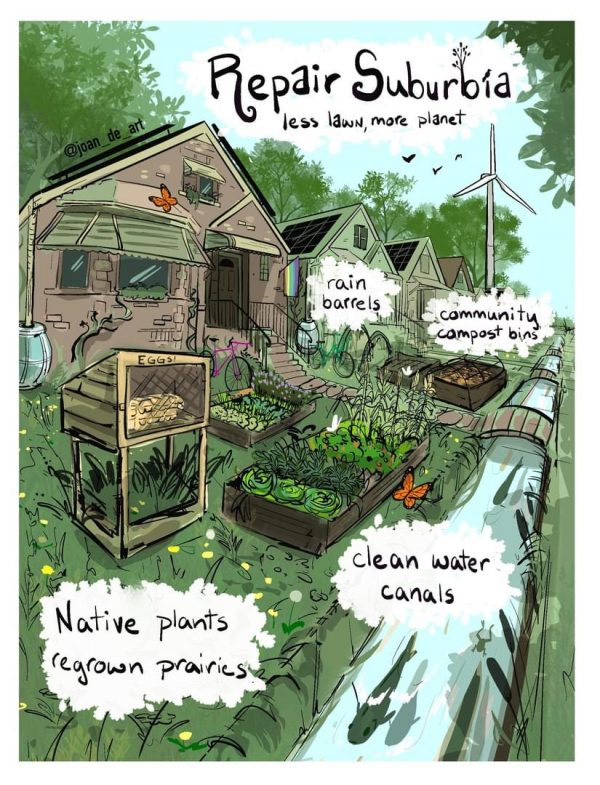This article is an introduction to Solarpunk as a vision, culture and movement of radical hope. Part explainer, part analysis, and part strategy, I offer my lens as an organizer on the potential political value of the Solarpunk vision for movements, as well as extensive resources for further engagement and exploration.
Both the content and form aim to be Solarpunk, in that the article itself is a network of many links to a diverse range of art, writing, videos, on thought and practice for exploration and engagement. The article is published as part of the creative commons, so it is free and encouraged to share. I ask that when you share, you preserve the links within the body and at the end to maintain this intentional form and give others the chance to explore with us.
We might begin this immersive exploration by ♫ turning up the volume ♫ and contemplating hope for a generation, just beyond my reach, not beyond my sight…
“I wanna drip like honey from the honeybee
Walk from the river down to the sea
Fly through the thick of a thunder cloud
Break down
Down on the people that won’t allow
Not gonna let them keep me
Not gonna let them hold me
Not gonna let them tell me no
Hope for a generation
Just beyond my reach
Not beyond my sight”
– Hope for a Generation, Fat Freddy’s Drop
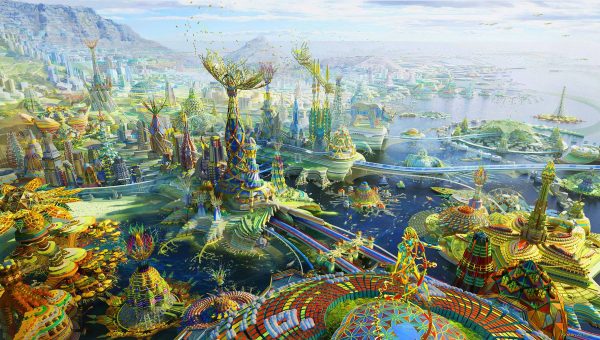
Art by @kristenzirngibl
Dear Hope, a reply
Aren’t you also tired of headlines expounding yesterday’s news? Lines like, “The world is hurtling towards and past ecological tipping points while ghoulish inequality and waste continue to skyrocket”. If you’re my age or younger, which most of you are, you grew up on this ‘news’. Whatever your age, since you’re here reading about radical hope, I don’t need to alert you to ecological collapse and global inequality, nor impart the gravity of it. Frankly, even if this was a post in the latest Vogue or Wall Street Journal or Sports Illustrated, I wouldn’t need to expose it or impart the gravity of it. We know.
I am not suggesting that we ought to ignore yesterday’s news. Rather, I am demanding that we start talking creatively, yet seriously, about today and tomorrow. We want to have a choice other than denial or depression. We want to channel our outrage and our dread and our exhaustion.
A colleague of mine, long-time activist and ‘OG of the Left‘, Michael Albert, recently penned a letter addressed ‘Dear Hope‘ asking, “who is Hope?” and proposing that she is us, the youth. Michael posits that, “We need to wake up, not as in those past times to escape utter ignorance and attain anger—but in these current times to escape lethargic defeatism and attain vision-fueled desire”. He then asks the relevant question, “Can Hope do that?”. Can hope create, “a surge able to construct lasting movements, lasting organization, lasting vehicles of outreach, and able to construct carefully conceived and truly inspiring examples and messages”?
It’s a tall order. But if you agree with either of us, an elder who perhaps never grew up and a young(ish) person who, like most of my generation, was born old, “yes of course, Hope can do that”.
But will Hope do that? Maybe hope is already in action. If we look at recent activity in labor organizing, reproductive justice organizing, anti-racist organizing, anti-fascist organizing, anti-debt organizing, and ecological organizing, isn’t each on the rise? Perhaps, but we need a sustained, holistic movement that continues to pursue positive vision as it carves out a strategic path towards fundamental change, and we need it now.
If we accept that we are Hope, we must answer the last question: “So, Dear Hope, what’s next?”. The only way to relegate yesterday’s news to the dustbin of history is to rebel today by re-imagining tomorrow. We must conceive, share, and engage with worthy vision to inform and fuel strategy, to provide structure and guidance for building the new, and to engender solidarity, commitment, and dare I say, hope.
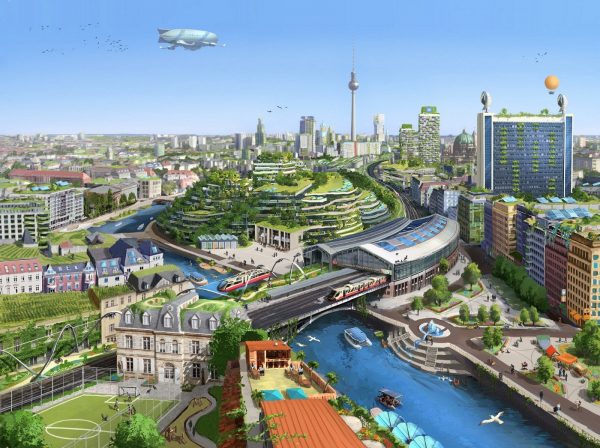
A “Solarpunk Berlin” by Alex Rommel
What does Hope look like?
To begin, in an age when civic, political, and social engagement is widely perceived as grey, or even in more toxic, putrid hues, how might we attract and engage wide participation in imagining and building a better future? Is hope green? Is it red? Does it look like me or you, me and you? Can I show it to you? Or is it reserved for those with time, resources, and inclinations toward reading volumes of political theory and economic texts? Can you find it in a story, a picture, or a song? Does radical hope have a culture?
Perhaps we need to see hope, to feel the emotions it engenders, to experience the relationships it fosters. When I write and talk about vision and strategy, I want to actually go there. I want to work towards a future that feels like going home, finally, to a place I have as yet only imagined. In the words of Eduardo Galeano, “Utopia is on the horizon. I walk two steps, it moves two steps away and the horizon runs ten steps further. So, what is utopia for? That’s what it’s for, it’s for walking”. If I could show you hope, would it move you to walk with me?
One such path towards the utopian imaginary, Solarpunk is a vision and aesthetic that elevates both human and ecological interconnectedness and reciprocity, quality of life, regenerative kinship, communal, and economic relations, play, creativity, diversity, participation, and a culture of abundance.
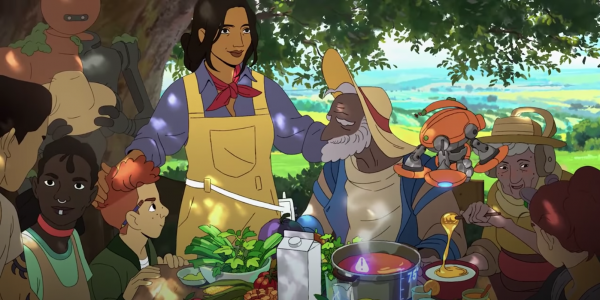
Image from the ‘Dear Alice’ Decommodified Edition by Waffle to the Left
What is Solarpunk?
Solarpunk is new enough that you’ll have to right click your word processing software to instruct it to “learn spelling”, yet old enough that when you see it, you’ll recognize that you’ve seen it before. For this article, I’ve also had to teach Word to spell Anthropocene, Afrofuturism and Earthship… it’s official, Microsoft is definitely not Solarpunk. Perhaps LibreOffice does better.
Solarpunk originated in Brazil in the early 2000s. In 2008, a blog named Republic of the Bees published the post, “From Steampunk to Solarpunk“, beginning the conceptualization of solarpunk as a literary genre. In 2012, a short story collection published in Brazil, “Solarpunk: Histórias Ecológicas e Fantásticas em um Mundo Sustenavel“, gained more public attention, followed quickly by Solarpunk’s morph into an online art genre.
These days, it is sometimes referred to as a lifestyle, an aesthetic, a genre, or a movement. Could it become an umbrella counterculture that fosters solidarity and visionary cohesion among diverse yet aligned movements? Like any culture, Solarpunk can be expressed in visual, literary, musical, social, and political terms, anything from housing to fashion to activism that seeks to answer and embody the question ‘what does a sustainable and just civilization look like, and how can we get there?’. As a popular Solarpunk facebook group states, “Solarpunk is about finding ways to make life more wonderful for us right now, and for the generations that follow, extending life at the species level, as well as individually.”

Solarpunk Civilization, artist unknown
The politics of Solarpunk
Solarpunk is a young and evolving concept, with various interpretations. Essentially, it rejects dystopian pessimism and, instead, puts forward regenerative aspirations that challenge us to alter our social habits. Appropedia’s Solarpunk page collects further political analysis and offers a selection of work from Solarpunk activists who are, “envisioning a positive future beyond scarcity and hierarchy, in which humanity is reintegrated with nature, and technology is used for human-centric and ecocentric purposes.”
Speaking up amongst these activists, Elvia Wilk emphasizes a socially radical understanding that, “Pleasant green architecture means nothing if it becomes an extension of colonialist fantasy via the narratives of the same heroes that much Steam and Cyber abound with.” Jeet Heer brings up accessibility and outreach, “Solarpunk writers are interested in how an ecologically balanced post-scarcity sustainable future will look and feel to ordinary people”. A statement in the wiki of r/solarpunk subreddit emphasizes participation with, “Solarpunk is everything from a positive imagining of our collective futures to actually creating it. The only reason why we don’t live in a solarpunk world right now is because no one has bothered to make it yet. We’ll have to make it ourselves, and we’ll have to help each other make it. That’s why it is solarpunk”. And others like T.X. Watson remind us that a diversity of thought and practice is Solarpunk – we must work both within and outside of the system to effect radical change: “I think in today’s activism, diversity of tactics has another important connotation, all the way on the other end. Participate in the system. Engage in local politics… A better future doesn’t blossom if no-one plants seeds. So make gardens out of Town Hall where radical politicians grow, and see what happens to the tower of fascism when the bottom floor crumbles. Sorry for mixing metaphors”.
While the name builds on the -punks of Cyberpunk and Steampunk, it resists the technological determinism and nihilism of the former and the Eurocentric and even human-centric imaginary of the later. While other -punk aesthetics show a vision of a high-tech society with a low quality of life, of high individualism and lack of community, Solarpunk turns it upside down to elevate low-tech and existing-tech solutions that can provide a high quality of life. It reveals that we don’t need to depend on future technology as our savior when we can start implementing social innovations now using existing technology. In a Solarpunk society, technology is a tool that serves the people and the planet, as opposed to a tool owned by the few to enslave the many while destroying the planet. Solarpunk builds on the abundance of the commons and rejects artificial scarcity. It celebrates individuality and diversity, and rejects greed and individualistic culture. It is punk in the sense that it insists on fundamental societal change from the roots through all levels. It is the -punk in Solarpunk where genre becomes movement.
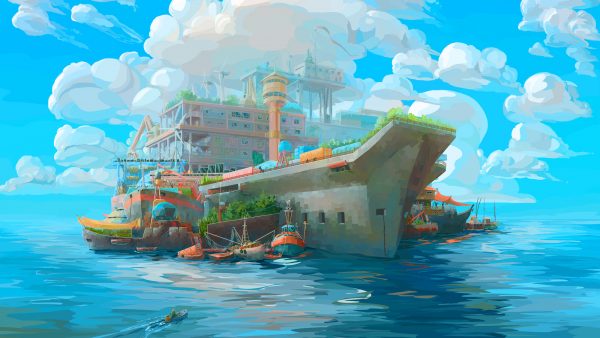
PortableCity by Shel Kahn
Greenwashing vs the Solarpunks
If Hope might look Solarpunk, she is already a target for greenwashing and other forms of cooptation.
Expropriation attempts are already well underway. Recently, the US company Chobani, hired The Line animation firm to produce the solarpunk-inspired ‘Dear Alice’ commercial. The video essay channel Waffle To The Left’s response to this brazen attempt to co-opt a post-capitalist vision into an advertisement for a dairy company was to take a stand by taking back the Solarpunk vision, and the video itself, to its radical roots. Waffle to the Left states, “Dear Alice is one of the most beautiful depictions of an ecological future I had seen, except for one glaring thing: it was an advertisement for a dairy company, and my solarpunk vision doesn’t have either of those things. Neither is compatible with the ‘degrowth’ economic model outlined by people like Jason Hickel, nor with the ethic of an ecological society described by social ecologists like Murray Bookchin. In light of that fatal flaw, I decided to paint out all of the branding and recreated the sound design so that solarpunks like myself can enjoy this beautiful world without having to invite the ugliness of capitalism into it. Enjoy!”
This incident is not isolated and unfortunately, not representative of all outcomes. Many famous “counterculture” festivals may have had Solarpunkish roots and display Solarpunkish fashion, yet have slid decidedly toward capitalist, consumerist and individualistic culture and structures. This is not to say that anyone involved in such an event is a sellout, but rather that these events are not truly representative of the Solarpunk movement. Imitation and cooptation is not all bad news however, it means that a counterculture is beautiful, fun, and interesting, all things that make it a powerful outreach tool to introduce and engage people with the deeper messages and practices via the aesthetic.
Hope is attractive, both to profiteers and to revolutionaries. Hope is cool. Via deep and sustained grassroots organizing, the benefits reaped by participants in meaningful Solarpunk experiences are exponentially richer than for those who bought a ticket, dressed up as a Dune character, and woke up with nothing more to take home than a hangover, and nothing more to share than an expensive selfie. It may be easy for the powerful to co-opt exiting trends, but inauthentic, empty imitations cannot replicate worthy vision and life-changing practice shared by many. Radical hope is more than a flash in the pan.
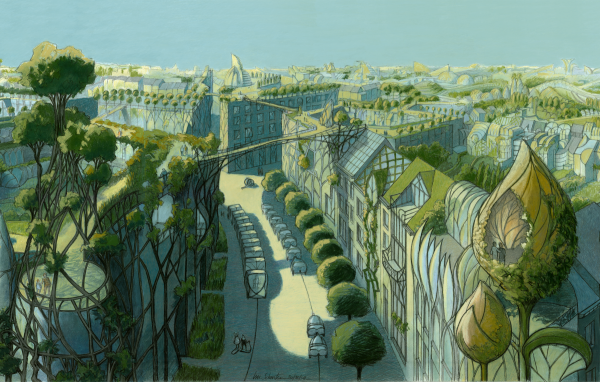
Vegetal City Panorama by Luc Schuiten. In this example of a solarpunk world, new technologies will bring humans and nature closer together, even integrating living vegetation into the structure of our cities.
Utopianism
What about utopianism that veers towards the unattainable or the ineffectual? Is Solarpunk, or positive vision in general, a waste of time and a wet blanket on the flame of revolution, an optimistic salve where we should be drumming up our rage? Jennifer Hamilton wrote a 2017 political analysis of Solarpunk, in which she points out, “Solarpunk’s optimism towards the future is the first concept that needs complicating here. Along with the original punks, there is a wide body of scholarship that critiques positive thinking. Feminists like Barbara Ehrenreich and Sara Ahmed, for instance, trace links between the capitalist establishment and happiness. They suggest that future-centred optimism serves the very system raged against by most punks of old”. Are Solarpunks visionary thinkers and doers worthy of the -punk suffix? Will our pretty dreams lull us back to sleep? How does hope remain radical, relevant, and effective?
To remain radical is where clarity of vision comes in. In any movement, we must be rooted in value centered vision and from there navigate ever changing contexts. Like the Chobani commercial or the glitzy festival, a picture of a steel and glass luxury apartment building with lots of plants, a green roof, and solar panels is not, on its own, Solarpunk because the fundamentals of the Solarpunk vision depart completely from hegemonic norms of our current society. The social, ecological, economic, and communal context and implications of this pretty greenified building are what determines whether or not it is Solarpunk.
To remain relevant and effective, hope cannot be a replacement for strategy. Rather, hope is an essential component of being strategic. Vision anchors practice, guides relevant and flexible strategy, and fuels hope and solidarity which increases the ranks of committed participants in a movement. The oldschool punks and feminists are absolutely right, hope on its own, without vision, strategy, and participation is an opiate in the service of the establishment.
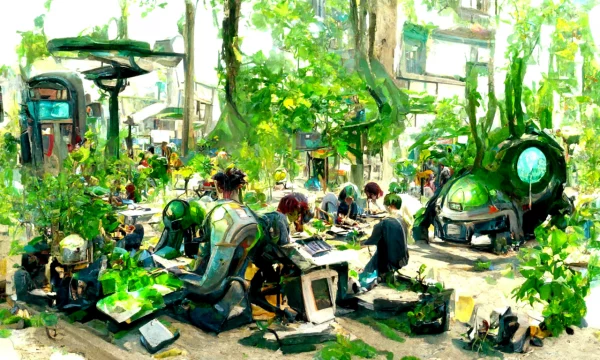
Solarpunk Reading Hall, Image generated via AI by Unknown
Solarpunk at home, work, and in community
What about life beyond YouTube and Instagram? Eventually, beautiful, inspiring, radical Hope must jump off the page and out of the box to become real. Along with a visual style, the spirit of Solarpunk is one of craftsmanship, egalitarianism, and positive vision where creativity, technology, and participatory community can be put to work to solve our greatest problems. Social innovation and participation must be a fundamental component, reimagining all realms of life from kinship, to community, to polity, to economy.
Solarpunks are building the future via projects like co-ops, community gardens, citizen assemblies, tenant unions, co-housing, care and resource sharing, free stores, bike kitchens, repair cafes, and establishing various circular and gift economies. Mutual aid is Solarpunk. Growing a food lawn instead of a grass monoculture, developing a communal “library of things“, fixing and mending and repurposing as opposed to buying and disposing are all Solarpunk. Embracing the kindergarten logic ‘sharing is caring’ is Solarpunk. Using technology that lets nature do its thing is Solarpunk. Living onboard a sailboat, I use simple low-tech solutions like a windscoop for cooling, sails for moving, and a rain catchment system for fresh water. Planting a shade tree near your home to use less air conditioning is Solarpunk. However, isolationism, setting up yourself to be perfectly Solarpunk without any concern for or efforts to engage with others, is not Solarpunk. Hope grows by sharing and becomes tangible by doing. Since the full benefits of hope are fully reaped only after its seeds have been sown, hope in action becomes regenerative.
What about bigger systemic applications? Too much traffic and pollution in your city? Expensive and difficult to get from home to work? Instead of building bigger highways or simply making more electric cars, a Solarpunk infrastructure project could be building up clean public transportation, transport shares and then transitioning to a commons of transport, reorganizing residential, productive, and communal spaces to become better integrated and more accessible, etc. Solarpunk compliments practical social vision and movements ranging from participatory society, to degrowth, to social ecology, to library socialism, to rebuilding the commons, to solidarity economies, to honoring and learning from indigenous cultures. Solarpunk’s values are rooted in the traditions of anarchism, socialism, ecological reciprocity, and human creativity, while it rejects the dogmas of history and seeks instead to imagine a new aspirational future.
What does hope look like? Can you show it to me? Yes. Solarpunk can help us see, hear, feel, and immerse ourselves in the future we are building. That is hope.
What’s next, dear Hope? Who is Hope and what can Hope do? When you and I, in community, plant the seeds of the future in the present, we are at once hope and the gardeners of hope. When we connect the radical imaginary to practice, we are hope.
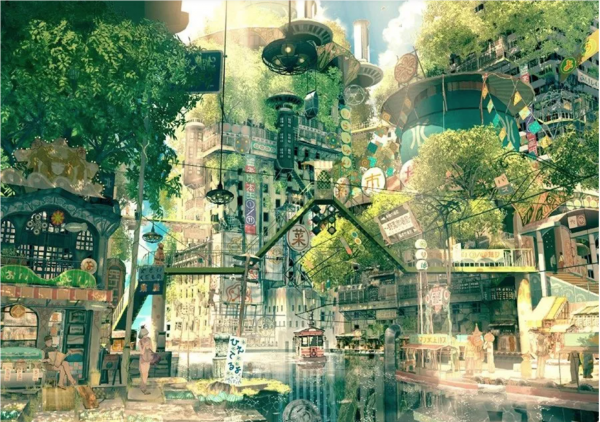
Art by Imperial Boy
Solarpunk Appetizers
If you haven’t had enough yet, the below list will continue to elaborate on the Solarpunk vision and provide more links for enjoying some of its fruits. Like all the diverse, visionary imaginatives available within Solarpunk culture itself, this list is by no means exclusive or perfect, but rather explorative and experimental.
There is also much content that predates the use of the word ‘Solarpunk’ which is foundational to the genre – from Miyazaki films, to Le Guin’s The Dispossessed and Always Coming Home, to Frank Lloyd Wright’s organic architecture and Michael Reynold’s Earthships, to inspirational motifs from Art Nouveau and Afrofuturism.
If you wonder whether other projects and content are Solarpunk, ask whether it imagines and advances vision, strategy, and practice for an equitable, non-hierarchical, post-scarcity society where humans live in diverse ways within ecological boundaries and in solidarity with each other. In other words, Elon Musk and Jeff Bezos attending a yoga retreat at the fusion powered organic juice bar & wellness spa on Mars is not Solarpunk. It’s also probably gross, sorry for that image. Instead, imagine using resources available to you now to help develop a community food garden/workshop and encouraging your yoga instructor neighbor to facilitate sessions there as part of a skills & education exchange. This is most definitely Solarpunk. One more time… Terracidal billionaires stuffed into survival pods festooned with greenery, while the 99% are conspicuously absent = not Solarpunk, and certainly not what hope looks like. Folks refusing dystopia, repairing and radically re-imagining their lives and communities together, and beginning to enjoy and spread the resulting benefits today as they carve a path towards tomorrow = Solarpunk. That’s what hope looks like.
Refuse Dystopia by @joan_de_art
Repair Suburbia by @joan_de_art
‘Dear Alice’ Decommodified Edition, video (1.5 min) by Waffle to the Left
Solarpunk in 7 minutes: The Case for Utopia, video (7 min) by Think That Through
Why This Gives Me Hope for the Future, video (12 min) by Our Changing Climate
How We Can Make Solarpunk A Reality, video (23 min) by Andrewism
Solarpunk Prompts, a Solarpunk podcast for writers
- Discusses Solarpunk as a movement within art, literature, and activism, explores its themes, and talks about what separates it from its genre peers. Each episode explores a writing prompt set in a Solarpunk aesthetic with examples and inspirations from our world today.
The Monk & Robot Series, novellas by Becky Chambers
- A hopeful and thoughtful journey through an eco-anarcho-socialst future that asks the timeless question: ‘what do humans need?’
The Ministry for the Future, novel by Kim Stanley Robinson
- Fictional eyewitness accounts tell the story of how climate change will affect us all. Its setting is not a desolate, postapocalyptic world, but a future that is almost upon us.
Lo–TEK: Design by Radical Indigenism, video (3.5 min) & book by Julia Watson
- A cumulative body of multigenerational knowledge, practices, and beliefs, countering the idea that indigenous innovation is primitive and exists isolated from technology.
The Great Derangement: Climate Change and the Unthinkable, book by Amitav Ghosh
- Are we deranged? Indian novelist Amitav Ghosh argues that future generations may well think so. How else to explain our imaginative failure in the face of global warming? Ghosh suggests that politics, much like literature, has become a matter of personal moral reckoning rather than an arena of collective action. But to limit fiction and politics to individual moral adventure comes at a great cost. The climate crisis asks us to imagine other forms of human existence—a task to which fiction, Ghosh argues, is the best suited of all cultural forms. His book serves as a great Solarpunk-writer’s summons to confront the most urgent task of our time.
Braiding Sweetgrass: Indigenous Wisdom, Scientific Knowledge And The Teachings Of Plants, book by Robin Wall Kimmerer
- Potawatomi professor Robin Wall Kimmerer writes about the role of Indigenous knowledge as a complementary approach to Western mainstream methodologies and ontologies. The scope of this book ranges from botany to colonialism, from climate change to kinship, and finally from history to strategy for winning a better world.
A Solarpunk Manifesto, by The Solarpunk Community
- Last but not least, a manifesto. There is no THE manifesto, as Solarpunk is a decentralized movement. There is no one sole organization or one lone voice that speaks officially or exclusively for all Solarpunks.
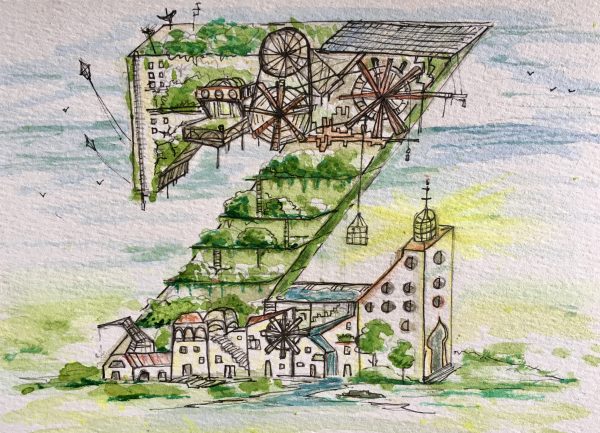
Solarpunk Z by M.V.
Art by Jessica Perlstein. This piece was created as concept artwork for a film based off of the novel The Fifth Sacred Thing by Starhawk. The story is set in 2048, where an ecotopian San Francisco defends itself from invaders using nonviolence.




